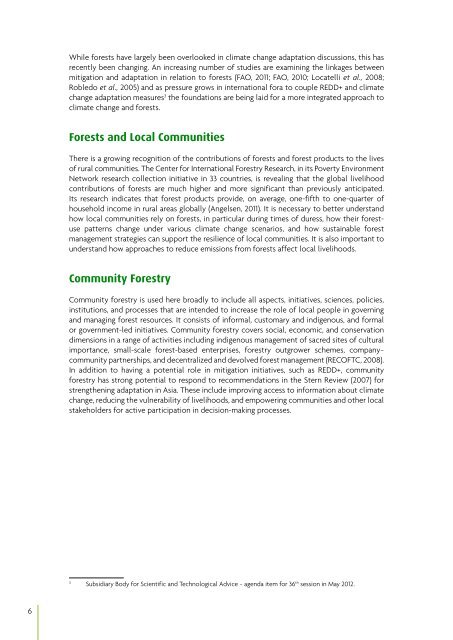Adaptation case studies.pdf - RECOFTC
Adaptation case studies.pdf - RECOFTC
Adaptation case studies.pdf - RECOFTC
Create successful ePaper yourself
Turn your PDF publications into a flip-book with our unique Google optimized e-Paper software.
While forests have largely been overlooked in climate change adaptation discussions, this hasrecently been changing. An increasing number of <strong>studies</strong> are examining the linkages betweenmitigation and adaptation in relation to forests (FAO, 2011; FAO, 2010; Locatelli et al., 2008;Robledo et al., 2005) and as pressure grows in international fora to couple REDD+ and climatechange adaptation measures 3 the foundations are being laid for a more integrated approach toclimate change and forests.Forests and Local CommunitiesThere is a growing recognition of the contributions of forests and forest products to the livesof rural communities. The Center for International Forestry Research, in its Poverty EnvironmentNetwork research collection initiative in 33 countries, is revealing that the global livelihoodcontributions of forests are much higher and more significant than previously anticipated.Its research indicates that forest products provide, on average, one-fifth to one-quarter ofhousehold income in rural areas globally (Angelsen, 2011). It is necessary to better understandhow local communities rely on forests, in particular during times of duress, how their forestusepatterns change under various climate change scenarios, and how sustainable forestmanagement strategies can support the resilience of local communities. It is also important tounderstand how approaches to reduce emissions from forests affect local livelihoods.Community ForestryCommunity forestry is used here broadly to include all aspects, initiatives, sciences, policies,institutions, and processes that are intended to increase the role of local people in governingand managing forest resources. It consists of informal, customary and indigenous, and formalor government-led initiatives. Community forestry covers social, economic, and conservationdimensions in a range of activities including indigenous management of sacred sites of culturalimportance, small-scale forest-based enterprises, forestry outgrower schemes, company−community partnerships, and decentralized and devolved forest management (<strong>RECOFTC</strong>, 2008).In addition to having a potential role in mitigation initiatives, such as REDD+, communityforestry has strong potential to respond to recommendations in the Stern Review (2007) forstrengthening adaptation in Asia. These include improving access to information about climatechange, reducing the vulnerability of livelihoods, and empowering communities and other localstakeholders for active participation in decision-making processes.3Subsidiary Body for Scientific and Technological Advice − agenda item for 36 th session in May 2012.6
















